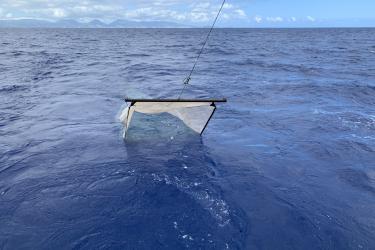The 2017 Hawaiian Islands Cetacean and Ecosystem Assessment Survey (HICEAS, pronounced “high-seas”) is a 187-day survey for cetaceans (whales and dolphins) and seabirds within the U.S. waters of the Hawaiian Islands. The goals of this project are to estimate how many cetaceans are in Hawai'i, examine their population structure, and understand their habitat.
HICEAS is large, multi-disciplinary effort that includes several types of data collection, which means that in order for things to run smoothly there has to be a well thought out plan. Teams from the Pacific Islands and Southwest Fisheries Science Centers have been meeting and coordinating for several months to design the survey and develop data collection protocols.

A crane loads heavy gear, here the net reel for retrieving an acoustic mooring, onto the Sette. Credit: NOAA Fisheries/Rachel Holton
Two NOAA Ships, the Oscar Elton Sette and the Reuben Lasker, will house a team of over 25 scientists to collect data during HICEAS. The Sette (homeport: Pearl Harbor, O'ahu) is used for a variety of projects near the Hawaiian Islands, which means that it is constantly being rearranged. Before the team can get underway, the ship needs to be equipped with all the right gizmos and gadgets relating to the HICEAS project.

The “wet lab” space on the Sette awaits organization, so that activities ranging from biopsy sample processing to hexacopter maintenance can occur seamlessly. Credit: NOAA Fisheries/Rachel Holton
As HICEAS approached, it was all hands on deck to load the Sette. A loading schedule was created to allow enough time for different groups to load the ship. For example, the heavy equipment was scheduled for 9 a.m., and food delivery was scheduled for 10:30 a.m. This was to avoid a bottleneck of people and materials and prevent smashing the food deliveries with hefty gear!

HICEAS Chief Scientist, Erin Oleson (front right) and team members Kym Yano, Marie Hill, and Amanda Bradford (left to right) focus intently on setting up the big-eye binoculars that will be used to search for cetaceans during the survey. Credit: NOAA Fisheries/Rachel Holton
Cranes are used to load four pairs of giant (“big-eye”) binoculars, the winch for the towed hydrophone array, crates of equipment, small boats, and other heavy gear, but a lot of packing and loading is done manually by the team of scientists preparing to live aboard the ship. The equipment must be cleaned and greased to ensure that everything will work efficiently for the duration of the cruise. Planning and packing for a cruise of this size takes a lot of preparation.

HICEAS Lead Acoustician, Jennifer Keating, sets up the acoustics “cave” on the Sette to receive whale and dolphin sounds from the deep. Credit: NOAA Fisheries/Rachel Holton
The Sette is now underway for HICEAS. While everyone gets their sea legs and gets back into the groove of ship life, the team tackles another aspect of getting large project underway- tackling equipment and software gremlins. Most of those sneaky noises, software bugs, and missing duct tape mysteries have now been worked out, and the preparations begin to set up the Lasker in San Diego before their journey to Hawai'i to join the HICEAS mission.


